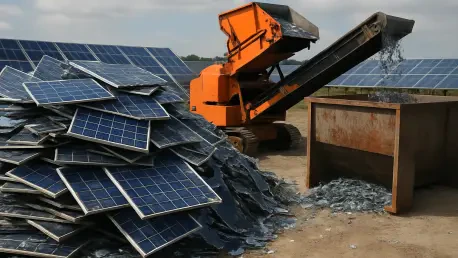In a world increasingly reliant on renewable energy, the challenge of managing solar panel waste looms large, with millions of panels reaching the end of their lifespan each year and creating an urgent need for sustainable solutions. As the global push for clean energy accelerates, the accumulation of discarded photovoltaic cells poses both an environmental hazard and a missed opportunity to reclaim valuable materials like silver and silicon. A groundbreaking initiative in Australia, however, is stepping up to address this pressing issue. Lithium Universe, listed on the Australian Securities Exchange, has partnered with Macquarie University to develop a cutting-edge recycling prototype. This collaboration, seeking support through a national funding program, could redefine how the renewable energy sector handles waste and resource scarcity. By focusing on innovative technologies and scalable solutions, this project highlights a critical intersection of sustainability and technological advancement, offering a glimpse into a future where recycling could play a pivotal role in the renewable energy ecosystem.
Breaking New Ground in Recycling Technology
Harnessing Innovative Methods for Resource Recovery
The partnership between Lithium Universe and Macquarie University is pioneering a novel approach to solar panel recycling by integrating two advanced technologies: microwave joule heating technology (MJHT) and jet electrochemical silver extraction (JESE). This combination aims to recover high-purity silver at over 96% quality, along with intact glass and reusable silicon wafers from end-of-life photovoltaic cells. Unlike traditional methods that often damage valuable components or rely on harmful chemicals, this process preserves the integrity of silicon wafers for high-value applications. Furthermore, it slashes processing times dramatically, reducing what once took hours or even days to just minutes. The environmental benefits are equally compelling, as the method uses dilute acids instead of toxic substances and incorporates a closed-loop electrolyte recirculation system to eliminate waste. This initiative, set to transition from lab testing to a pilot prototype within a 12-month timeframe starting in early 2026, represents a significant leap forward in sustainable resource recovery.
Scaling Up for Global Impact
Beyond the technical innovation, the project’s ambition to position Australia as a leader in solar panel recycling underscores its potential for global influence. The collaboration is seeking funding through Australia’s Economic Accelerator (AEA) Ignite program, with a total request of $385,728, supported by contributions from both partners. If successful, this funding will accelerate the development of a scalable prototype, paving the way for commercialization. The emphasis on speed and efficiency aligns with broader national priorities, including advancing renewable technologies and achieving net-zero emissions. By focusing on high-value material recovery, such as silver for reuse in new solar cells and electronics, the initiative addresses critical resource shortages that threaten the renewable energy supply chain. This forward-thinking approach not only tackles the mounting issue of solar waste but also sets a precedent for other nations to follow, potentially transforming the global landscape of renewable energy recycling with a model that prioritizes both economic and environmental outcomes.
Aligning Sustainability with Policy and Economic Goals
Addressing the Solar Waste Challenge Head-On
The growing volume of solar panel waste presents a formidable challenge as the renewable energy sector expands, but this Australian initiative offers a timely response with far-reaching implications. Lithium Universe chair Iggy Tan has highlighted the alignment of this project with federal government priorities, emphasizing its role in supporting critical minerals processing and sustainable technology development. The urgency to manage end-of-life panels is driven by both environmental concerns and the need to recover scarce resources like silver, which is vital for solar cell production. This recycling effort stands out for its focus on a circular economy, ensuring that materials are reused rather than discarded, thereby reducing reliance on finite reserves. The integration of cutting-edge methods like MJHT and JESE not only minimizes ecological impact but also positions the project as a cornerstone of sustainable innovation. As solar installations continue to proliferate worldwide, such solutions are essential to prevent waste from undermining the very benefits that renewable energy promises.
Building a Future Through Strategic Funding
Securing financial backing through programs like AEA Ignite, which has previously supported numerous innovative projects across Australian universities, remains a critical step for this recycling initiative. The funding will enable the transition from experimental research to practical application, ensuring that the technology can be tested and refined at scale. Beyond the immediate benefits of resource recovery, the project contributes to broader economic goals by fostering job creation and technological leadership in the renewable energy sector. The commitment from Lithium Universe, including significant cash and in-kind contributions, demonstrates a strong belief in the viability of this solution. Moreover, the emphasis on zero-waste processes through closed-loop systems reflects a holistic approach to sustainability that could inspire similar efforts globally. As the renewable energy industry grapples with balancing growth and environmental responsibility, strategic investments in projects like this one are vital to shaping a future where recycling and renewable energy go hand in hand.
Reflecting on a Sustainable Legacy
Looking back, the collaborative effort between Lithium Universe and Macquarie University marked a significant milestone in addressing the solar panel waste crisis through innovative recycling technology. Their pursuit of funding through the AEA Ignite program underscored a commitment to turning laboratory breakthroughs into real-world solutions. As the project gained traction, it became evident that the focus on recovering high-purity materials and minimizing environmental impact had set a new standard for the industry. The next steps involved not only scaling up the prototype but also inspiring international cooperation to adopt similar sustainable practices. Policymakers and industry leaders were encouraged to prioritize investments in recycling infrastructure, ensuring that the renewable energy sector could maintain its promise of a cleaner planet. By building on this foundation, the vision of a circular economy in renewables moved closer to reality, offering a blueprint for tackling resource scarcity and waste management challenges on a global scale.









